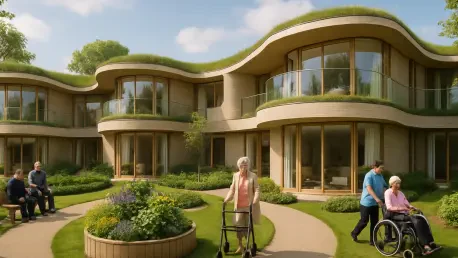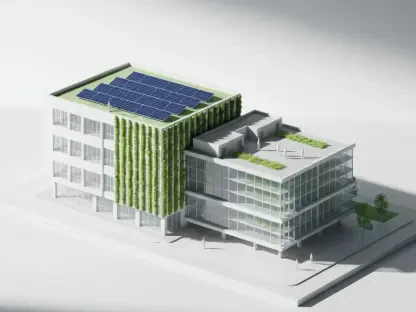Imagine a community where aging loved ones can thrive in a space that blends cutting-edge care with the warmth of a vibrant neighborhood, a vision that is becoming reality in Heybridge, near Maldon, Essex. With the recent approval of a 66-bed care home at Vistry’s Westcombe Park, this development has sparked conversations across the region about the future of residential care and community integration. This roundup gathers insights, opinions, and perspectives from various stakeholders and industry voices to explore what this project means for local residents and the broader care sector. The aim is to shed light on the innovative features, sustainability efforts, and community impact of this facility while comparing diverse viewpoints on its potential.
Diverse Perspectives on a Milestone Development
Design Innovation: Luxury Meets Practical Care
Insights from architectural and care industry professionals highlight the thoughtful design of the three-story care home, which includes en-suite wet rooms, communal lounges, a sky bar, a cinema, and a hair salon. Many commend the emphasis on resident comfort, noting that such amenities elevate the standard of living for those in care. The focus on accessibility, with features like designated parking for electric vehicles and mobility scooter storage, is often praised as a forward-thinking approach to inclusivity.
However, not all feedback aligns on the balance between luxury and practicality. Some voices in the care sector express concern that high-end features might divert resources from core care services, questioning whether such amenities are necessary for all residents. This divide reveals a broader debate on how care homes should prioritize spending while still meeting diverse needs.
A third perspective emphasizes adaptability, suggesting that the design’s flexibility—such as communal spaces that can serve multiple purposes—could address these concerns. Industry observers note that the layout appears to cater to both social engagement and individual care, potentially setting a new benchmark for care home architecture in the region.
Sustainability Efforts: Green Goals in Focus
On the topic of sustainability, environmental advocates and developers agree that the care home’s eco-friendly features are a significant step forward. The integration of ground source heating, photovoltaic panels, and energy storage systems has been lauded as a model for reducing carbon footprints. Many point out that these measures not only lower operational costs but also align with Essex’s broader environmental targets.
Contrasting opinions emerge regarding the scalability of such initiatives. Some industry analysts argue that while the technology is impressive, the upfront costs could deter smaller developers from adopting similar practices. They caution that without incentives or subsidies, sustainable design might remain limited to larger projects like Westcombe Park.
A middle ground is offered by sustainability consultants who suggest that phased implementation of green technologies could bridge the gap. They argue that starting with cost-effective solutions and scaling up over time—perhaps from 2025 to 2027—could make eco-friendly care homes more accessible, encouraging wider adoption across the sector.
Community Integration: A New Role for Care Homes
The care home’s placement within the larger Westcombe Park plan, which includes a health center, retail spaces, and later living apartments, draws varied reactions. Urban planners and community leaders often view this as a progressive move, breaking away from the traditional isolation of care facilities. They emphasize that embedding care within a mixed-use development fosters a sense of belonging for residents.
Some local residents and advocacy groups, however, raise questions about infrastructure strain. Concerns center on whether the surrounding amenities and services can support an influx of residents and visitors, particularly in terms of traffic and healthcare access. This perspective calls for more detailed planning to ensure the community remains cohesive.
A contrasting insight from regional development experts highlights the potential for Westcombe Park to inspire future projects. They suggest that Heybridge’s approach could redefine care homes as community hubs, encouraging social interaction and economic growth, provided that local feedback is actively incorporated into ongoing plans.
Specialized Care: Addressing Critical Needs
The dual focus on general residential care and dementia-specific support garners widespread approval from healthcare professionals. Many note that this tailored approach addresses a pressing demand in aging populations, particularly as dementia cases rise. The consensus is that specialized services enhance the quality of life for residents with unique needs.
Differing views surface on how well such facilities can adapt to future healthcare trends. Some in the medical field worry that rigid designs might struggle to accommodate emerging care models or technologies over time. They advocate for modular spaces that can evolve with changing requirements.
Another angle comes from policy analysts who see this care home as a testing ground for innovative care strategies. They propose that data and outcomes from this facility could inform regional policies, potentially shaping how specialized care is delivered in Essex and beyond, ensuring long-term relevance.
Key Takeaways from the Discussion
Reflecting on the varied insights, it’s evident that the care home at Westcombe Park has sparked robust dialogue about design, sustainability, community integration, and specialized care. Stakeholders largely celebrate the innovative amenities and green initiatives, though opinions diverge on balancing luxury with practicality and scaling eco-friendly practices. The project’s role within a broader neighborhood plan is hailed as visionary by some, while others urge caution regarding infrastructure challenges. Specialized care offerings receive strong support, tempered by calls for adaptability to future needs.
Looking back, these discussions underscore the complexity of modern care home development. They highlight a shared commitment to improving quality of life while navigating practical constraints. For those intrigued by this evolving landscape, actionable next steps include engaging with local planning committees to voice concerns or ideas about Westcombe Park. Exploring similar mixed-use developments in other regions can also provide valuable context. Ultimately, staying informed about care innovations and advocating for inclusive, sustainable communities remains a powerful way to shape the future of residential care.









